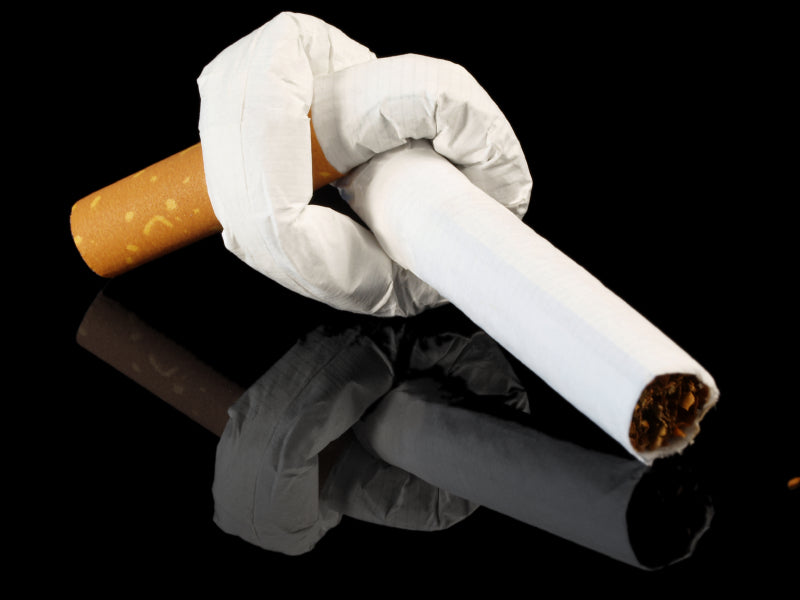INFORMATION ON QUITTING SMOKING
THE CIGARETTE - PUBLIC ENEMY NO. 1
The harmfulness of tobacco is well known - what is less well known are the very different consequences of different types of tobacco consumption. The most important subdivision of tobacco consumption is the distinction between "smoke" and "smokeless" - the first category is much more harmful than the second because most of the harmful substances of tobacco are only released during the combustion process. According to official figures from the Federal Office of Public Health (FOPH), 9500 people die in Switzerland every year as a result of tobacco consumption - that is 26 people a day. For the general public, the costs are in the billions: 5 billion Swiss francs per year, to be precise. This figure is made up of the costs of medical treatment (3 billion) on the one hand, and the costs of loss of earnings due to incapacity to work (2 billion) on the other. This is not only the case in Switzerland: smoking is the biggest avoidable health risk in the western industrialised nations and the most important risk factor for noncommunicable diseases worldwide - no wonder with over 1 billion smokers worldwide; almost 1/8 of the entire world population!
The health consequences of smoking have been proven in numerous studies. The fact is that the life expectancy of daily smokers is reduced by an average of 14 years compared to non-smokers. In addition, half of all daily smokers die prematurely, half of them before the age of 70. Smokers die most frequently of cardiovascular diseases, followed by lung cancer, respiratory diseases and other types of cancer. Cardiovascular diseases are responsible for 35% of all tobacco-related deaths, lung cancer for 28%, the remaining cancers for 17% and 16% from respiratory diseases.
The most striking feature of these statistics is that the majority of health complaints resulting from tobacco consumption are related to the burning process and its serious consequences for the respiratory tract. To eliminate this problem, it is of course clear that a complete stop of all tobacco products would be the best solution - if only it were that simple: according to a study by the Swedish government, 90% of all smokers have tried or are considering stopping smoking. The problem is the nicotine and the ritual; habits that are very difficult to eliminate. But what is often forgotten in the tobacco discussion is the approach of "harm reduction" as a simpler alternative to complete abstinence. However, this approach is now being pursued by numerous states, and follows the scientific evidence for up to 95% reduction of harmful substances when the combustion process is eliminated and the tobacco category is switched to "smokeless". That this approach promises success is proven by figures from the home country of snus: Sweden has the lowest smoking rate in the world (5-10%) and therefore also the lowest lung cancer rate in the world. In contrast, other cancers such as oral cancer are not more widespread than in countries where "smokeless" tobacco is not consumed.
Based on these facts, we believe that the "smokeless" category can significantly reduce (up to 95%) the tobacco problem and its serious consequences for public health and thus the national economy. Our aim is therefore to educate as many smokers as possible about this alternative and to encourage them to switch to it if complete abstinence is not successful. Below we inform you about the reactions of the body when you stop smoking and are of course available to answer any questions you may have by phone, e-mail or Whatsapp.
WHAT HAPPENS IN YOUR BODY WHEN YOU STOP SMOKING TOBACCO CIGARETTES
AFTER 8 HOURS
Already 8 hours after stopping smoking your body starts to recover. In fact, the first noticeable effect of not smoking is already apparent within these first hours: the amount of oxygen in the blood starts to return to normal levels; even if you are now using snus. This allows your body to begin to eliminate the carbon monoxide that you have stored in your body through smoking. As a result, you will have more oxygen in your blood and feel better in many ways.
AFTER 24 HOURS
Within 24 hours after you quit smoking and/or start snus, your body will have got rid of the rest of the carbon monoxide in your system. But your lungs will also be detoxified as they remove toxic residues and mucus that have accumulated during smoking. This is possible because you no longer inhale any additional toxins and give your body the chance to finally heal and cleanse itself. This is also possible if complete abstinence from tobacco does not work and you are now consuming snus - because you have eliminated the toxins contained in cigarette smoke.
AFTER 48 HOURS
After 48 hours your body will continue to thank you for quitting smoking or switching to snus. At this time you will probably find that your sense of taste has improved so that eating and drinking is fun again. In addition, your sense of smell will become stronger, so that you will be able to perceive more of the smells that you missed while smoking. All this is possible because your body is now able to repair the receptors in your mouth and nose that have been damaged by the toxins from cigarettes.
AFTER 72 HOURS
After all the incredible improvements in your body for 48 hours, it should come as no surprise that your body changes even more in three days. Anyone who completely eliminates tobacco or switches to snus will notice that their breathing has already improved by that time. Breathing is easier than when smoking because you are no longer exposed to the tar that has irritated and clogged the bronchi. Once this health hazard has been eliminated, former smokers notice that their energy level increases and breathing becomes less difficult.
3 TO 9 MONTHS
If you can stay away from tobacco cigarettes for 3 to 9 months, you should notice that panting, coughing and shallow breathing have decreased significantly or disappeared completely; even if you should be consuming snus by now. These changes are also due to improved lung function as the body has been able to eliminate the dangerous residues that have accumulated during smoking.
5 YEARS
Let us now look at the long-term effects of smoking cessation. In five years, the risk of heart attack has dropped by about half.
10 YEARS
Within 10 years, the risk of lung cancer will decrease by about half of what it was with regular smoking. Your risk of heart attack will also decrease to about the same as it would be for someone who has never smoked. If you continue to use snus, the effects of nicotine on the heart should not be trivialised - but this effect is similar to the effect of caffeine.
CONTINUE!
The longer you can remove the tobacco cigarettes, the more you will notice that your health improves. Your body will thank you for quitting smoking and for drastically reducing the risk of many (respiratory) diseases. In addition, the people around you will no longer be exposed to the harmful smoke that you used to produce with your tobacco cigarettes.




 Dieses Produkt schädigt Ihre Gesundheit und macht stark abhängig.
Dieses Produkt schädigt Ihre Gesundheit und macht stark abhängig.